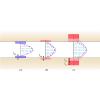当前位置:
X-MOL 学术
›
Phys. Rev. E
›
论文详情
Our official English website, www.x-mol.net, welcomes your
feedback! (Note: you will need to create a separate account there.)
Mesoscopic method to study water flow in nanochannels with different wettability.
Physical Review E ( IF 2.2 ) Pub Date : 2020-07-09 , DOI: 10.1103/physreve.102.013306 Tao Zhang 1, 2 , Farzam Javadpour 2 , Xiangfang Li 1 , Keliu Wu 1, 3 , Jing Li 3 , Ying Yin 4
Physical Review E ( IF 2.2 ) Pub Date : 2020-07-09 , DOI: 10.1103/physreve.102.013306 Tao Zhang 1, 2 , Farzam Javadpour 2 , Xiangfang Li 1 , Keliu Wu 1, 3 , Jing Li 3 , Ying Yin 4
Affiliation

|
Molecular dynamics (MD) simulations is currently the most popular and credible tool to model water flow in nanoscale where the conventional continuum equations break down due to the dominance of fluid-surface interactions. However, current MD simulations are computationally challenging for the water flow in complex tube geometries or a network of nanopores, e.g., membrane, shale matrix, and aquaporins. We present a novel mesoscopic lattice Boltzmann method (LBM) for capturing fluctuated density distribution and a nonparabolic velocity profile of water flow through nanochannels. We incorporated molecular interactions between water and the solid inner wall into LBM formulations. Details of the molecular interactions were translated into true and apparent slippage, which were both correlated to the surface wettability, e.g., contact angle. Our proposed LBM was tested against 47 published cases of water flow through infinite-length nanochannels made of different materials and dimensions―flow rates as high as seven orders of magnitude when compared with predictions of the classical no-slip Hagen-Poiseuille (HP) flow. Using the developed LBM model, we also studied water flow through finite-length nanochannels with tube entrance and exit effects. Results were found to be in good agreement with 44 published finite-length cases in the literature. The proposed LBM model is nearly as accurate as MD simulations for a nanochannel, while being computationally efficient enough to allow implications for much larger and more complex geometrical nanostructures.
中文翻译:

介观方法研究具有不同润湿性的纳米通道中的水流。
分子动力学(MD)模拟是目前最流行且最可靠的工具,用于模拟纳米级的水流,传统的连续方程由于流体-表面相互作用的主导而破裂。但是,当前的MD模拟对于复杂的管几何形状或纳米孔网络(例如膜,页岩基质和水通道蛋白)中的水流在计算上具有挑战性。我们提出了一种新颖的介观格子玻尔兹曼方法(LBM),用于捕获波动的密度分布和流经纳米通道的水的非抛物线速度分布。我们将水和固体内壁之间的分子相互作用纳入了LBM配方。分子相互作用的细节转化为真实的和表观的滑移,两者均与表面润湿性(例如接触角)相关。我们提出的LBM已针对47种已发布的案例进行了测试,这些案例是通过不同材料和尺寸制成的无限长纳米通道的水流情况的,与经典的无滑移哈根·泊瓦(HP)流量的预测相比,流量高达七个数量级。使用已开发的LBM模型,我们还研究了通过有限长度纳米通道的水流的管子入口和出口的影响。结果与文献中公布的44个有限长度案例非常吻合。所提出的LBM模型几乎与纳米通道的MD模拟一样准确,同时计算效率足以允许涉及更大,更复杂的几何纳米结构。
更新日期:2020-07-09
中文翻译:

介观方法研究具有不同润湿性的纳米通道中的水流。
分子动力学(MD)模拟是目前最流行且最可靠的工具,用于模拟纳米级的水流,传统的连续方程由于流体-表面相互作用的主导而破裂。但是,当前的MD模拟对于复杂的管几何形状或纳米孔网络(例如膜,页岩基质和水通道蛋白)中的水流在计算上具有挑战性。我们提出了一种新颖的介观格子玻尔兹曼方法(LBM),用于捕获波动的密度分布和流经纳米通道的水的非抛物线速度分布。我们将水和固体内壁之间的分子相互作用纳入了LBM配方。分子相互作用的细节转化为真实的和表观的滑移,两者均与表面润湿性(例如接触角)相关。我们提出的LBM已针对47种已发布的案例进行了测试,这些案例是通过不同材料和尺寸制成的无限长纳米通道的水流情况的,与经典的无滑移哈根·泊瓦(HP)流量的预测相比,流量高达七个数量级。使用已开发的LBM模型,我们还研究了通过有限长度纳米通道的水流的管子入口和出口的影响。结果与文献中公布的44个有限长度案例非常吻合。所提出的LBM模型几乎与纳米通道的MD模拟一样准确,同时计算效率足以允许涉及更大,更复杂的几何纳米结构。











































 京公网安备 11010802027423号
京公网安备 11010802027423号